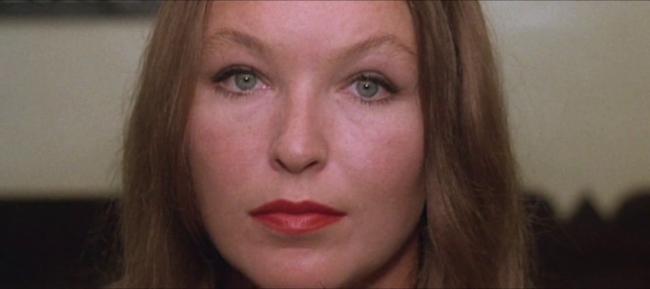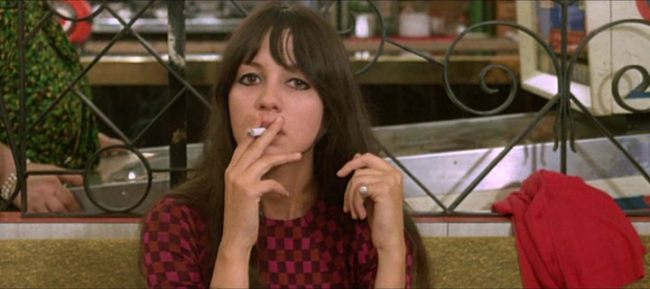
Does the ultimate meaninglessness of language or symbols pull people apart or bring them together? Does the question pull a movie apart or bring it together? Jean-Luc Godard moves away from his more character driven films of the early 1960s with 1967's Two or Three Things I Know About Her (2 ou 3 choses que je sais d'elle), a film that mostly seems to be Godard's way of conveying his own impression of critical theory in vogue at the time and how he applies it to politics, society, and personal relationships. In so doing, he presents people who don't become characters, dryly expositing in a movie that doesn't quite become a movie. Which doesn't seem to be a mistake--Wikipedia quotes Godard himself as saying, "In other words, it isn't a film, it's an attempt at a film and presented as such." Like most of Godard's New Wave films, it forces the viewer to contemplate the artificial and manipulative nature of film or art in general, a process redeemed here by the genuinely intriguing quality of some of Godard's ideas and the beauty of his actresses but this film lacks the vitality of his earlier films.

Mostly the movie follows Juliette (Marina Vlady), a housewife and mother who moonlights as a prostitute. She almost never engages in any conventional dialogue and spends most of the film breaking the fourth wall, telling the audience things about herself, making observations about the nature of language, or talking about the war in Vietnam, at one point observing how strange it is that someone in France could care about a stranger in Asia.

Here the film becomes an arena for contemplating the new media access to the horror of war in the 1960s and applying to it contemporary critical theory. What do these images of people suffering so far away mean while Juliette and the other people in the film are caught up contemplating arbitrary symbols? Juliette's little boy tells her about a dream he had where he saw a pair of twins merge into each other which he explains to her symbolises the merging of north and south Vietnam. The absurdity of a child explaining the meaning of his dream as such an explicit political allegory is placed alongside Godard's usual subversion of film language, insisting that the audience realise at all times the choices implied by the images they're seeing. When Juliette goes to a gas station, she explains to the audience how the station might have been shot from many different angles, drastically changing the tone and inferred meaning.

The film makes an explicit reference to Jean Cocteau's Orphee, one character taking down mysterious messages from the radio, even noting as he does so that he saw something similar in a movie. In this we see essentially Cocteau's interpretation of Cocteau's film for his current, personal purposes and the lure of symbols takes on sinister connotations. Relentless questions are directed at women, sexually objectifying them.

Another woman is shown at a cafe, speaking to a man off-screen, while someone noisily plays pinball behind her. The never seen man asks her if she's afraid of sex, she says no, and then he repeatedly asks her to say that her sex organ is between her legs. She repeatedly refuses and he insists it's because she's afraid which she denies. By continually controlling the conversation and remaining out of frame, he in some sense dictates the nature of the reality we perceive of her. Similarly, another scene has Juliette and a fellow prostitute obliging a client by walking around naked wearing tote bags on their heads.

Only their bodies remaining while their heads, their identities, are replaced by airline logos.
Much of this ground is covered in Pierrot le fou, which is made more charming by the chemistry between its stars Jean-Paul Belmondo and Anna Karina. Vlady as Juliette isn't bad but she doesn't have Karina's star quality, or maybe what she lacks is a real spiritual or creative rapport with the director to naturally elevate his philosophy to a more organic place. But Two or Three Things I Know About Her is an interesting visual essay about people lost and alienated in a wilderness of symbols.
Twitter Sonnet #846
The palm was carved to hold the egg in place.
The longer string'll make the cello trip.
A fleet retires now to greener grace.
Neglected whiskey gleams at ev'ry sip.
A stone replaced the face in lights at home.
Descending spider facsimiles sing.
Perfunct'ry trumpets break heralding Rome.
A bear applauds a tired echo ring.
Judicious jade'll jumble fruit in freight.
A bean or cowrie fails at Marshalsea.
The button left for tithe'll take your weight
The caviar was bruised at Battersea.
A marshmallow rejects the clock for fat
Consensus says the Hutt's a heavy prat.

No comments:
Post a Comment